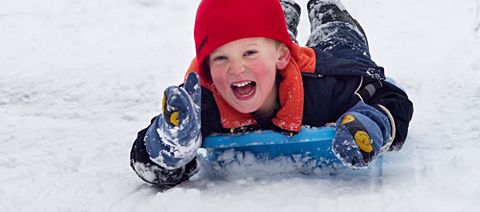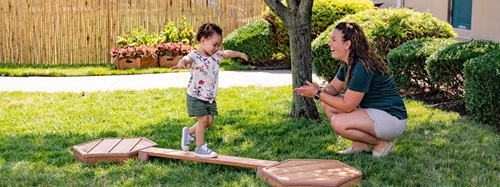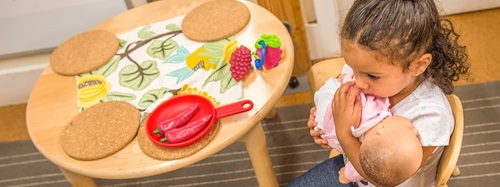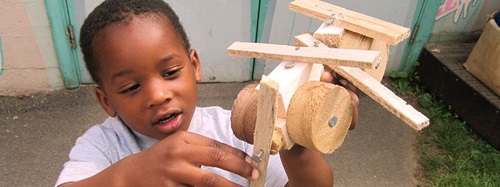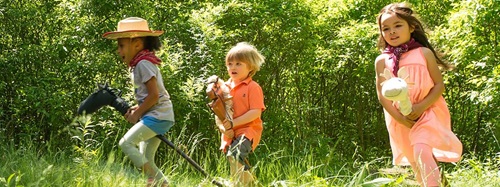Embracing Life with Enthusiasm
Supporting Young Children to Become Competent, Confident, Courageous, and Resilient
|
August 2013
“Young children need challenge and risk within a framework of security and safety. The outdoor environment lends itself to offering challenge, helping children learn how to be safe and to be aware of others. Children are seriously disadvantaged if they do not learn how to approach and manage physical and emotional risk. They can become either timid or reckless, or be unable to cope with consequences.” [1]
What helps you to embrace life with enthusiasm? What helps you to take advantage of opportunities that make your life richer, more interesting and more successful? What is it about you that enables you to go for a new, as yet untried or intriguing experience?
Some of these things have to do with how we think about the challenge involved and its risks: is it too scary, will I be able to do it, will it go wrong, can I manage if it doesn’t work out? Feeling safe and comfortable in a novel experience comes from having developed a sense that we can cope with the challenges around us, and manage the consequences if things do not go as planned.
If children are to be able to take advantage of the opportunities their lives offer them, and grow into people who feel like they can “go for it”, deal with uncertainty and enjoy whatever happens, then they need a childhood filled with opportunities to develop the appropriate dispositions, knowledge and competencies that allow them to both feel secure and to be safe. Consider too that challenge has physical, emotional, social and intellectual components, so children need to build “risk-competency” in all of these areas.
The risk of no-risk
I am very aware from my work in the UK that the outdoors is seen as more dangerous than indoors for young children, with “outdoor play” and “risk” almost being contingent terms in the minds of many practitioners and parents. Since accident statistics simply do not bear this out, I suspect that media and marketing share much of the blame for this creeping belief. Such increasing fear levels in our societies, with the resultant change in childhood experience, are of great concern because of the harm that this is so ironically doing!
The danger is that, by attempting to remove risk, we remove the vital opportunity to become “risk competent”. For children’s well-being and all-round development, it seems that the consequences of not taking risks could be more severe than the potential dangers in risk-taking. If we are raising a generation who have not learned to manage risk for themselves, will they be able to make sensible decisions, and will they have the capacity to keep themselves safe? Will they be fearful of new experiences and unwilling to try things out?
Benefiting from challenge and risk through play outdoors
“Young children need to be able to set and meet their own challenges, become aware of their limits and push their abilities (at their own pace), be prepared to make mistakes, and experience the pleasure of feeling capable and competent. Challenge and its associated risk are vital for this. Young children also need to learn how to recognize and manage risk as life-skills, so as to become able to act safely, for themselves and others.” [1]
Among its many benefits, playing and learning outdoors has the positive value of being more able to offer challenge and stretch in all sorts of ways, providing opportunities for children to find out about their own boundaries and to push at them. Indeed, humans are biologically primed and driven to do this as a continuous task throughout childhood! While the vulnerability of children is strongly at the forefront of our minds, the Scandinavian view of children, childhood and cultural values seems more balanced towards the robustness of children and the desirability of a resilient, risk-competent population.
There are three important pillars that support a child’s ablity to embrace life with enthusiasm, and it is our task as adults involved in the child’s upbringing to work hard at putting them in place:
- Being ready: feeling that life is positive and therefore being able to explore and become engaged. Being ready also requires a robust sense of “self”, with an, “I can” rather than, “I don’t believe I can” approach to life.
- Being willing: experiencing strong motivation for an activity and therefore wanting to persist (if at first you don’t succeed, try, try, try again). This also requires the construction of resilience towards “mistakes” and “failures”, together with the ability to learn positively from them.
- Being able: as well as dispositions and attitudes, knowledge must be built up through authentic experience, so that the child actually acquires the skills and competencies needed to be and feel safe. This includes becoming able to look forward to judge possible consequences and being able to deal with them if they should occur, and also thinking about consequences for others and knowing how to help them.
How are these dispositions, knowledge, and skills built?
Children can only learn through real, hands-on, and challenging experiences supported by more knowledgeable guides, such as adults, who are also ensuring that inappropriate risks are removed.
- They need many opportunities to learn about themself from the inside, calibrating their body and emotions in relation to the demands of life.
- They must have opportunities to gain knowledge about the world, learning how it works and behaves.
- As well as becoming aware of potential risks in their actions so that they can manage them, children need to learn to react positively when unexpected things do happen, and draw on suitable responses to keep themself safe. This means experiencing tricky (appropriately risky) things, in a supportive and nurturing environment, so that a personal response repertoire can be gradually acquired!
The role of the ECE setting
“Safety of young children outdoors is paramount and a culture of ‘risk assessment to enable’ that permeates every aspect of outdoor provision is vital for all settings. Young children also need to feel secure, nurtured and valued outdoors. This includes clear behavioral boundaries (using rules to enable freedom), nurturing places and times outside, and respect for how individual children prefer to play and learn.” [1]
It is our duty and task to ensure that our children grow up able to embrace life with enthusiasm: to understand their limits but seek to push them at a comfortable level and pace, to know how to keep themselves and others safe, to be adventurous and have courage, to be able to enjoy the uncertainty of new experiences through knowing (a deep belief gained by personal experience) that they can cope with this, and to bounce back when things have not gone well. These need to be internalized so that the child really believes this about his or her self. This can be constructed only through a great deal of personal experience of suitable challenge (with appropriate risk), where they are supported or guided just enough to become independently successful.
Making this happen takes time, will, attention, and on-going effort. It requires conviction and a values-based, whole team approach; a clear and well-articulated rationale for the benefits of outdoor experiences and for offering challenge to children; parents who are well engaged with the desirability of play outdoors; lots of staff and parental discussion and professional development; attentive, confident and courageous educators who feel well supported; constant review and reflection; a framework of proportionate, reasonable and sufficient safety that enables beneficial experiences (making things as safe as necessary, rather than as safe as possible); forward thinking and contingency planning. However, the two most important strategies are to know each child well as an individual, working to that individual’s style, pace, and interests, and to actively involve children at the heart of your risk management processes.
What we are doing in the UK
In the UK, thanks to a very active play sector, we now have an established and positive government-endorsed approach to risk in play and education, enshrined in a high level statement from the government’s own Health & Safety Executive together with comprehensive guidance for a “benefit-risk approach” to risk management in place of risk removal [3]. We have a long journey ahead to turn around the juggernaut of risk aversion, high anxiety levels for our children and deep concerns about litigation, to reinstate the well-established connections between hands-on outdoor experience, challenge, risk-competency and positive life dispositions [2].
However, we really do seem to have begun that journey, and there is certainly a desire and willingness amongst many educators and play professionals to be brave enough themselves to address this. The “risk of no risk” has been recognized and is rising in our awareness to counter our risk-averse culture, such that we can be optimistic that our children might indeed become “competent, confident, resilient and self-assured” individuals [4], who can, both now and in their future, embrace life with joyous and brave enthusiasm.
[1] The Shared Vision and Values for Outdoor Play in the Early Years (The Vision & Values Partnership, 2004) can be downloaded from janwhitenaturalplay.wordpress.com
[2] Risk Competence: Towards a pedagogic conceptualisation of risk, Eichsteller, G. & Holthoff, S. (ThemPra Social Pedagogy C.I.C) is available at www.social-pedagogy.co.uk
[3] Managing Risk in Play Provision, Ball, D., Gill, T. & Spiegal, B. (Play England and the Play Safety Forum, 2008) is a downloadable PDF from www.playengland.org.uk
[4] Statutory Framework for the Early Years Foundation Stage (Department for Education, 2010) Principle of the Unique Child

